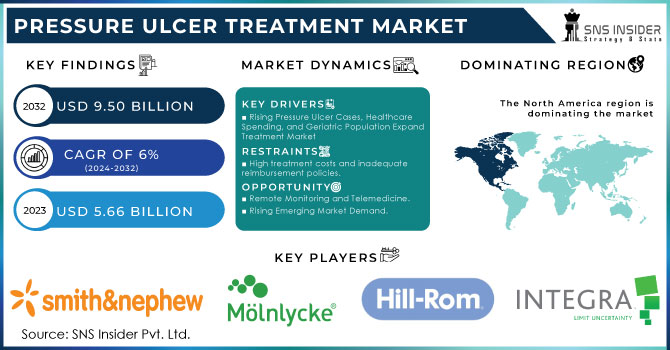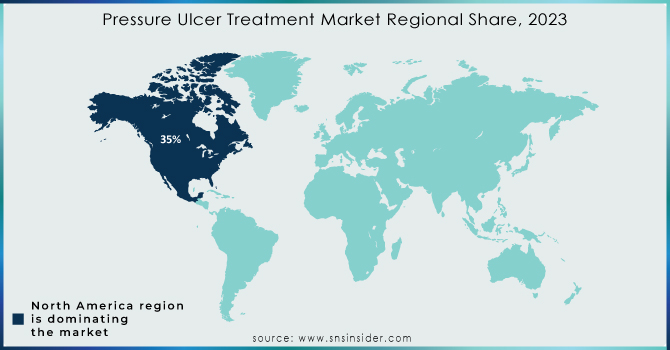Pressure Ulcer Treatment Market Report Scope & Overview:

To get more information on Pressure Ulcer Treatment Market - Request Sample Report
The Pressure Ulcer Treatment Market size was valued at USD 5.66 billion in 2023 and is expected to reach USD 9.50 billion by 2032 at a CAGR of 6% during the forecast period of 2024-2032.
The increase in the older population with chronic sickness and physical disabilities caused by pressure ulcers has created a need in the medical business for relevant therapies. Managing and treating pressure ulcers is one of the key elements driving the pressure ulcer treatment landscape. Furthermore, despite the fact that various healthcare providers in the business offer many breakthrough wound care equipment, dressings, and therapies, it is becoming a Gordian knot for healthcare institutions, including hospitals and community health centers.
Because treating pressure ulcers is significantly more expensive than preventing them, the field of pressure ulcer treatment is shifting toward preventative care approaches. Hospitals and healthcare facilities are employing cutting-edge movement tracking systems to improve patient care by reducing pressure ulcers. Furthermore, as new technologies develop to support the healthcare sector's digital transformation, digital parts of pressure ulcer avoidance systems are becoming more prevalent. With increasing awareness of the negative effects pressure ulcers have on patients' health and quality of life, demand for pressure ulcer remedies is predicted to rise by double digits.
MARKET DYNAMICS
DRIVERS
-
An increase in the number of patients with pressure ulcers, rising healthcare expenditure, an increase in the geriatric population, an increase in the adoption of artificial skin substitutes, rising government funding, and rising initiatives by government and private organizations to raise awareness about the negative impact of pressure ulcers on patient health and quality of life are all factors that will expand the pressure ulcer treatment market.
-
Increased R&D activities, significant unmet demands, and the development of therapeutic and diagnostic technologies will present favorable possibilities for the pressure ulcer treatment market between 2024 and 2031.
RESTRAIN
-
High treatment costs and inadequate reimbursement policies.
During the projection period, the high cost of treatment and unfavorable reimbursement policies in low-income countries would hamper market expansion and represent further difficulties for the pressure ulcer treatment market. Pressure ulcer treatment reimbursement is relatively limited, especially for novel and innovative treatments. Furthermore, such therapies are not covered by insurance, making it difficult for healthcare professionals to grant payment in such cases.
OPPORTUNITY
-
Remote Monitoring and Telemedicine.
-
Rising Emerging Market Demand.
-
Regenerative and personalized therapies.
CHALLENGES
-
Patient Compliance, Infection Control, and Limited Reimbursement Policies.
Infection is a major concern in the management of pressure ulcers. Infection prevention and management in these wounds can be difficult and may necessitate specialist techniques. Inadequate remuneration for pressure ulcer treatment and prevention initiatives can have an impact on healthcare providers' desire to invest in high-quality care. Effective pressure ulcer therapy frequently necessitates persistent patient compliance with wound care techniques, which can be difficult, especially in home settings.
IMPACT OF RUSSIA-UKRAINE WAR
Disruption in Healthcare Infrastructure Geopolitical wars, such as the one raging between Russia and Ukraine, can impair healthcare infrastructure, including hospitals, clinics, and medical supply networks. This disruption may have an impact on the availability and distribution of pressure ulcer therapy and wound care products. Conflict can interrupt the supply chain for medical products and equipment, potentially resulting in shortages of wound care supplies, specialty mattresses, and other devices used in pressure ulcer therapy.
IMPACT OF ONGOING RECESSION
Purchases that have been postponed or reduced Hospitals and healthcare facilities may postpone or restrict the procurement of medical equipment and supplies, particularly those used to treat pressure ulcers. Capital-intensive investments may be postponed, reducing demand for specialized pressure ulcer treatment devices and goods. Priorities in Healthcare Have shifted. Recessions can cause healthcare providers to prioritize cost-effective and important treatments. Pressure ulcer prevention and treatment may be prioritized over more urgent or life-threatening illnesses, affecting wound care resources. Disruptions in the Supply Chain Economic downturns can disrupt global supply chains, reducing the availability of pressure ulcer treatment supplies and wound care treatments. Shortages or delays in getting these goods may have an effect on patient care.
KEY MARKET SEGMENTATION
By Product Type
-
Wound Care Dressing
-
Other
By Type
-
Stage 1
-
Stage 2
-
Stage 3
-
Stage 4
By End-User
-
Clinics
-
Hospital
-
Homecare Settings
REGIONAL ANALYSES
North America will account for approximately 35% of the worldwide pressure ulcer therapy market. From 2024 to 2031, the region's market is expected to increase at a CAGR of 5.4%. Factors propelling the market in North America and Europe include an increase in the elderly population, an increase in the frequency of chronic diseases, and technological improvements.
During the projected period, Asia-Pacific is expected to be the fastest-growing region of the global market. The region's pressure ulcer treatment market is benefiting from increased awareness. During the forecast period, the Asia-Pacific market is expected to increase at a CAGR of 6.1%. The market in the Middle East and Africa, as well as Latin America, is expected to rise moderately in the near future. This is due to an increase in demand for wound dressings and artificial skin products in these areas.

Get Customized Report as per your Business Requirement - Request For Customized Report
REGIONAL COVERAGE
North America
-
US
-
Canada
-
Mexico
Europe
-
Eastern Europe
-
Poland
-
Romania
-
Hungary
-
Turkey
-
Rest of Eastern Europe
-
-
Western Europe
-
Germany
-
France
-
UK
-
Italy
-
Spain
-
Netherlands
-
Switzerland
-
Austria
-
Rest of Western Europe
-
Asia Pacific
-
China
-
India
-
Japan
-
South Korea
-
Vietnam
-
Singapore
-
Australia
-
Rest of Asia Pacific
Middle East & Africa
-
Middle East
-
UAE
-
Egypt
-
Saudi Arabia
-
Qatar
-
Rest of Middle East
-
-
Africa
-
Nigeria
-
South Africa
-
Rest of Africa
-
Latin America
-
Brazil
-
Argentina
-
Colombia
-
Rest of Latin America
Key Players
The major players are Smith & Nephew plc, Integra LifeSciences, Hill-Rom Holdings, Inc, Mélnlycke Health Care AB, Essity Aktiebolag, Cardinal Health, 3M, B. Braun Melsungen AG, Acelity LP., Inc., Coloplast Group, ConvaTec Group ple and others.
RECENT DEVELOPMENTS
Michelin debuted MICHELIN: In 2022, Michelin debuted MICHELIN AirProne at the Intensive Care Show 2022 in June 2022. Cushion set designed for people suffering from acute respiratory distress syndrome (ARDS).
| Report Attributes | Details |
| Market Size in 2023 | US$ 5.66 Bn |
| Market Size by 2032 | US$ 9.50 Bn |
| CAGR | CAGR of 6% From 2024 to 2032 |
| Base Year | 2023 |
| Forecast Period | 2024-2032 |
| Historical Data | 2020-2022 |
| Report Scope & Coverage | Market Size, Segments Analysis, Competitive Landscape, Regional Analysis, DROC & SWOT Analysis, Forecast Outlook |
| Key Segments | • By Product Type (Wound Care Devices, Wound Care Dressing, Other) • By Type (Stage 1, Stage 2, Stage 3, Stage 4) • By End-User (Clinics, Hospital, Homecare Settings, Ambulatory Surgical Centers) |
| Regional Analysis/Coverage | North America (US, Canada, Mexico), Europe (Eastern Europe [Poland, Romania, Hungary, Turkey, Rest of Eastern Europe] Western Europe] Germany, France, UK, Italy, Spain, Netherlands, Switzerland, Austria, Rest of Western Europe]). Asia Pacific (China, India, Japan, South Korea, Vietnam, Singapore, Australia, Rest of Asia Pacific), Middle East & Africa (Middle East [UAE, Egypt, Saudi Arabia, Qatar, Rest of Middle East], Africa [Nigeria, South Africa, Rest of Africa], Latin America (Brazil, Argentina, Colombia Rest of Latin America) |
| Company Profiles | Smith & Nephew plc, Integra LifeSciences, Hill-Rom Holdings, Inc, Mélnlycke Health Care AB, Essity Aktiebolag, Cardinal Health, 3M, B. Braun Melsungen AG, Acelity LP., Inc., Coloplast Group, ConvaTec Group ple |
| Key Drivers | • An increase in the number of patients with pressure ulcers, rising healthcare expenditure, an increase in the geriatric population, an increase in the adoption of artificial skin substitutes, rising government funding, and rising initiatives by government and private organizations to raise awareness about the negative impact of pressure ulcers on patient health and quality of life are all factors that will expand the pressure ulcer treatment market. |
| Market Restraints | • High treatment costs and inadequate reimbursement policies. |

